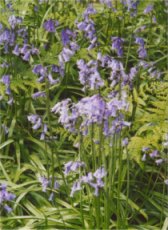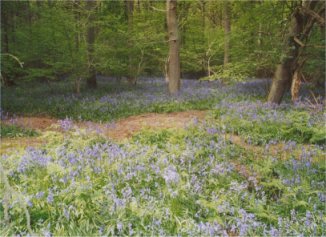"The Fragrance of Bluebells"
English Bluebells – Hyacinthoides non-scripta
(L.) Chouard ex Rothm.; syn. Endymion non-scriptus (L.) Garcke.
Copyright © Tony Burfield May 2002
 Bluebell plants are members of the Liliceae having small nodding purple-blue
cylindrical bell shaped flowers, with the tips of the petals curving back, and
possessing a strong but delicate fragrance. White and pink flowered forms are
also seen, but these are often solitary. They are not to be confused with the
Scottish bluebell Campanula rotundifolia (the harebell) Bluebells are
frequently seen in the woods of England, Wales and Scotland from April until
June, and are also cultivated as an ornamentals in gardens. The appearance of
Bluebells in the woods is a quintessentially English occurrence, and something
that in bygone days, young girls might look forward to, as armfulls of blooms
were frequently gathered from the woods and placed in jars back at home,
although they do not survive for long once cut. It used to be legal to do this
but nowadays due to their more threatened status, it is no longer so (see www.bbc.co.uk/nature/spring/bluebell.shtml).
Bulbs were used as a source of glue for book binding and for arrow flights at
one time.
Bluebell plants are members of the Liliceae having small nodding purple-blue
cylindrical bell shaped flowers, with the tips of the petals curving back, and
possessing a strong but delicate fragrance. White and pink flowered forms are
also seen, but these are often solitary. They are not to be confused with the
Scottish bluebell Campanula rotundifolia (the harebell) Bluebells are
frequently seen in the woods of England, Wales and Scotland from April until
June, and are also cultivated as an ornamentals in gardens. The appearance of
Bluebells in the woods is a quintessentially English occurrence, and something
that in bygone days, young girls might look forward to, as armfulls of blooms
were frequently gathered from the woods and placed in jars back at home,
although they do not survive for long once cut. It used to be legal to do this
but nowadays due to their more threatened status, it is no longer so (see www.bbc.co.uk/nature/spring/bluebell.shtml).
Bulbs were used as a source of glue for book binding and for arrow flights at
one time.
Being essentially wild hyacinths, as might be expected, bluebells have an
intense green floral, and b -phenylethyl alcohol-like odour, perhaps coloured
with a touch of phenylacetaldehyde, which fills the whole air. It might be bad
form to include the name of a chemical in an odour description, but really this
is the best way to describe it.
The unique, heady and intoxicating odour of English bluebells has not been
captured in the form of a commercially available absolute. Occasionally
synthetic bluebell fragrances are used in cosmetic and toiletry type
applications etc., which are often hyacinth-like in character. However the magic
of the natural fragrance can be experienced every year by those living near an
English Bluebell wood…..

BACK
TO MAGAZINE INDEX
 Bluebell plants are members of the Liliceae having small nodding purple-blue
cylindrical bell shaped flowers, with the tips of the petals curving back, and
possessing a strong but delicate fragrance. White and pink flowered forms are
also seen, but these are often solitary. They are not to be confused with the
Scottish bluebell Campanula rotundifolia (the harebell) Bluebells are
frequently seen in the woods of England, Wales and Scotland from April until
June, and are also cultivated as an ornamentals in gardens. The appearance of
Bluebells in the woods is a quintessentially English occurrence, and something
that in bygone days, young girls might look forward to, as armfulls of blooms
were frequently gathered from the woods and placed in jars back at home,
although they do not survive for long once cut. It used to be legal to do this
but nowadays due to their more threatened status, it is no longer so (see www.bbc.co.uk/nature/spring/bluebell.shtml).
Bulbs were used as a source of glue for book binding and for arrow flights at
one time.
Bluebell plants are members of the Liliceae having small nodding purple-blue
cylindrical bell shaped flowers, with the tips of the petals curving back, and
possessing a strong but delicate fragrance. White and pink flowered forms are
also seen, but these are often solitary. They are not to be confused with the
Scottish bluebell Campanula rotundifolia (the harebell) Bluebells are
frequently seen in the woods of England, Wales and Scotland from April until
June, and are also cultivated as an ornamentals in gardens. The appearance of
Bluebells in the woods is a quintessentially English occurrence, and something
that in bygone days, young girls might look forward to, as armfulls of blooms
were frequently gathered from the woods and placed in jars back at home,
although they do not survive for long once cut. It used to be legal to do this
but nowadays due to their more threatened status, it is no longer so (see www.bbc.co.uk/nature/spring/bluebell.shtml).
Bulbs were used as a source of glue for book binding and for arrow flights at
one time.